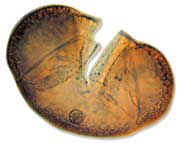
 |
||
 |
||
 |
What is Palynology, and Why is it Important?
For people with hay fever and allergies, pollen is something to be avoided whenever possible, but to palynologists, pollen is a treasure chest full of information. This powdery dust, which plants exchange in their reproduction cycle, is actually a collection of tiny individual grains. Each type of plant produces pollen grains that are different from those of other plants and can often be identified by careful study under a microscope. Palynology
(the study of pollen) provides information that helps us understand allergies,
monitor pollution, identify oil-bearing deposits, and much more.
Palynology
(the study of pollen) provides information that helps us understand allergies,
monitor pollution, identify oil-bearing deposits, and much more.
Illinois
State Museum
Pollen Studies
Scientists at the Illinois State Museum study fossil pollen to learn about vegetation (plants) and climates of the past. Most of the pollen they examine comes from sediment at the bottom of lakes or from deposits of peat (a very thick, moist material formed from partially decomposed plants).
What are some of the Museum's projects?
How Do We Study Fossil Pollen?
Pollen preserves best if its surrounding environment lacks oxygen (as in a lake bed) or is acidic (like peat). Because of their very small size, pollen grains dry out rather easily.
To help protect the inside of the cell, pollen has evolved a very tough outer "shell"-the part scientists usually find preserved. If the sediment stays wet, the pollen shell will survive for thousands or even millions of years.
How did the pollen get to the bottom of the lake or into a peat deposit?
What can the pollen tell us?
Steps in Processing Fossil Pollen
|
|
Copyright© 2000 Illinois State Museum Society